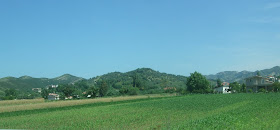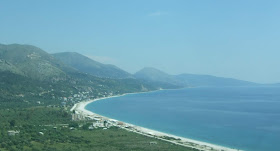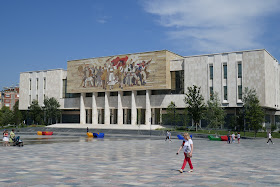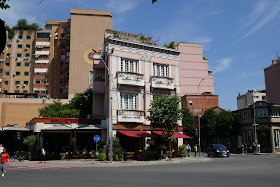South by the Scenic Route Beside the Adriatic and the Strait of Otranto
10/06/2019
Tirana to Vlora
 |
| Albania |
Edi turned up on time and we set off at 9 for a 300km journey that would take most of the day. Albania has a coastal plain (with occasional interruptions) but much of the interior is a massif riven by a series of river valleys, mostly running SE-NW, and the roads follow these. Any chosen route is a compromise and at some point you will find yourself making a detour, because that is the way the roads go.
We started heading south towards Elbasan on the sort of road you only find in and around Tirana.
 |
| South from Tirana on the A3. Mullet is a village beside the main road 10km south of the capital, the city of Elbasan is 30km further |
The road cuts through the hills…
 |
| Through the hills south of Tirana |
…before entering a wide valley where we were able to take a more south westerly route and by-pass Elbasan We were not sorry to miss it, Enver Hoxha persuaded the Chinese to build a steel mill there in 1974, other metallurgical industries followed and the city of 120,000 people is now reputed to be the most polluted in Albania.
 |
| Agricultural country, west of Elbasan |
We were largely reversing our route of two days ago, but this time not quite reaching Berat, though we had a good view of the Tomorri Mountains before swinging west towards Fier. We had passed through Fier when driving from Gjirokaster to Berat – one of those detours the mountains demand – and our quickest way from Fier to Saranda would be straight down the Drin Valley to Gjirokastër and then turn south west, but this was a day for the scenic route. We headed for the coast.
 |
| From Tirana in central Albania to Saranda in the south west corner |
We reached Vlora around 11.15. Vlora is a pleasantly neat and tidy port, agricultural and industrial centre on the Strait of Otranto linking the Adriatic and Ionian Seas. The Italian port of Brindisi is 130km away, while the nearest point on the heal of Italy is only 80km distant.
 |
| We reach Vlora |
Vlora sits in a sheltered inlet and the south of the city straggles down the inlet in a series of seaside resorts with shingle beaches.
 |
| Resort with single beach south of Vlora, with the Karaburun Peninsula in the hazy distance |
The Llogara National Park
The inlet is formed by the rocky Karaburun Peninsula partially closing the mouth of the bay. The peninsula is an extension of the Ceraunian Mountains which extend for 120km south from Vlora to beyond Saranda. Further south there is a strip of coastal plain, but for 20km or so the mountains drop into the sea; here the road runs parallel to the coast a kilometre of two inland through the Llogara National Park.
 |
| Into the Llogara National Park |
Established in 1966 (not everything from the Hoxha days is bad and wrong) the park is a mixture of forest (evergreen and deciduous), alpine meadows and rocky precipices. Near the coast the climate is Mediterranean, but becomes Alpine further inland where high ground is snow covered in the winter. The park is home to a wide range of species including griffon vulture, golden eagle, rock partridge, European wildcat, chamois, wolf and red squirrel.
 |
| The Llogara National Park |
The steady but relatively gentle climb into the mountains ends at the top of the Llogara Pass (1,027m) in the shadow of Mt Çika (2,044m) the second highest peak in the Ceraunians).
 |
| Mt Çika from the Llogara Pass - not that the summit is included! |
From here the descent to the Albanian Riviera is abrupt….
 |
| Looking south from the Llogara Pass, the large villages of Gjilek, Kondraq and Dhërmi in the middle distance are still some way above sea level. |
…and involves many hairpins bends.
 |
| Descending the Llogara Pass |
Dhërmi, the furthest and lowest of the three villages seen from the top of the pass is a seaside resort; 'loud music and parasols packed so tightly they touch' was the gist of one trip advisor review. The comment applies to the beachside hotels and bars, not to the dignified old village 200m up the cliff, and then only at high season, but there is no doubt the little town is set on development, regardless of topographical difficulties.
 |
| Dhërmi, near the bottom on the Llogara Pass |
More hairpins remained to be negotiated. At Iljas, 4km from Dhërmi, the road descended to cross the Gjilpe Canyon and then climbed to the village of Vuno. In November 1989 this was the scene of the Llogara Tragedy, an event more suited to a Casualty series finale than real life. A bus carrying students from the Agricultural University of Tirana left the road and plunged into a ravine. The authorities sent two helicopters to transfer the injured to Tirana, but by the time the casualties had been loaded, fog had descended. With the weather forecast predicting conditions would continue to deteriorate the pilots decided to take off immediately; one crashed near Vuno, the other on the pass. 23 died, there were no survivors.
Himarë
We descended to Himarë, a larger, well established, seaside resort with the advantage of actually being beside the sea - the town is expanding north and south along its attractive sandy beaches. Edi parked on the seafront and gently ushered us to one of a line of restaurants across the road.
 |
| Himarë seafront |
We sat on the terrace and waited while Edi had an extended conversation with the management, which he simplified to us as ‘the chef is off sick so there is no food today.’
We moved to the almost identical establishment next door and took up much the same position. We ordered tzatziki, bread, salad and beer, but before they came a minibus-load of elderly people arrived and sat round a large table in the garden. Both waiters advanced, pads in hands, and we watched as the menu was read, there was a show of hands, a decision was made followed by some dissension, another show of hands, another decision, further dissension and round again. I should not mock the elderly – I am one of them, even if I won’t accept it – but it did amuse us. Our food was only a little delayed, but we had hardly started when they brought another dish we had not ordered; we sent it away. At the end, our coffee came with an apology for earlier confusion. We had been very little inconvenienced by either the error or the slight delay, but they declined to charge us for the coffee.
Porto Palermo
A little further down the road is the pleasing sweep of Porto Palermo Bay. Once a Greek port called Panormos it was mentioned by Strabo (64 BCE-24 CE). It became Porto Palermo under the Byzantine Empire (Sicily's much larger Palermo underwent an identical name change).
 |
| Porto Palermo Bay |
The islet joined to the mainland by a causeway is the site of Porto Palermo castle, often ascribed to Ali Pasha Tepleni. (We encountered this 18th/19th century tyrant in Gjirokastër. The efficient but cruel and ruthless ruler of the western Balkans under the Ottomans, became the personification of an ‘oriental despot’ in western literature after a visit from Lord Byron). The design, though, suggests the fort is probably older and Venetian in origin.
Tucked into the northern corner of the bay is what Google maps coyly calls ‘the cave of Porto Palermo.’
 |
| The 'Cave of Palermo' |
It is, of course, not a cave but the entrance to a submarine bunker. Not so long ago taking this photograph would have landed me in jail for a very long time, but in the new Albania the authorities have generously built a viewpoint to help get the best picture I can.
 |
| Submarine bunker Porto Palermo |
In 2014 Huffington Post ranked Porto Palermo first in its list of 15 Undiscovered European Destinations. Palermo was discovered a couple of millennia ago, but in the Huff Post’s somewhat parochial sense, it is still waiting.
Saranda
The last 50km to Saranda were uneventful, give or take the odd sheep.
 |
| Road block, south of Porto Palermo |
We passed several crescents of shining sand. Development is happening and will almost certainly speed up, but at present the Albanian Riviera has most of Europe’s remaining unspoilt Mediterranean beaches.
 |
| Bay between Porto Palermo and Sarande |
Saranda is by far the Riviera’s largest resort, but for all the tutting over its overdevelopment, it remains small by most standards.
We attempted to check into the Hotel Porto Edda, but they had never heard of us. There was some discussion, Edi showed the booking on his phone, and his boss in Tirana joined in, but the young receptionist was out of her depth, her boss was unobtainable and she lacked the confidence to make a decision. Not so our man in Tirana who quickly rebooked us into the Hotel Brilant (sic), 500m down the road, where we were offered a small room redeemed by a large sea-and-Saranda-view balcony.
 |
| Saranda |
A cynical thought crossed my mind; our travel agent had originally suggested the Brilant, but we changed it to the Porto Edda as it was more central. Somehow, we had been manipulated back to the Brilant. Was it an accident? It mattered not, Saranda is small enough for centrality to be unimportant and we did like the balcony. Incidentally, Porto Edda was Saranda’s name during the Italian occupation - Edda being Mussolini’s daughter.
We took a walk to look at the town, scout out a restaurant, and buy some raki and ouzo (we weren’t in Greece, but we could see it) to take home. We chose a restaurant near the hotel, but it was not a great choice, there were few other diners and my eel was below expectations, though Lynne was happy with her cuttlefish.
 |
| Dinner in Saranda, eel and cuttlefish |
Then we had a nightcap on the balcony.
 |
| Saranda at night |
12/06/2019
Back to Corfu and thence Home
In the morning the light was different so we took another picture of Saranda…
 |
| Saranda in the morning |
…and one of Corfu.
 |
| Over the sea to Corfu |
After breakfast a driver took us round the bay to the ferry port.
In Corfu we were met by the same taxi driver as before and this time he had brought his Albanian wife. I think she wanted to speak to us, but we lacked a language in common; I hope her husband translated our positive impression of the current state of her former home. He was keen to talk about Brexit. ‘You must be mad,’ he said. We agreed.
And with that thought, we went home.
Part 3: Gjirokastër
Part 4: Berat
Part 5: Tirana
Part 6: Tirana to Saranda





























